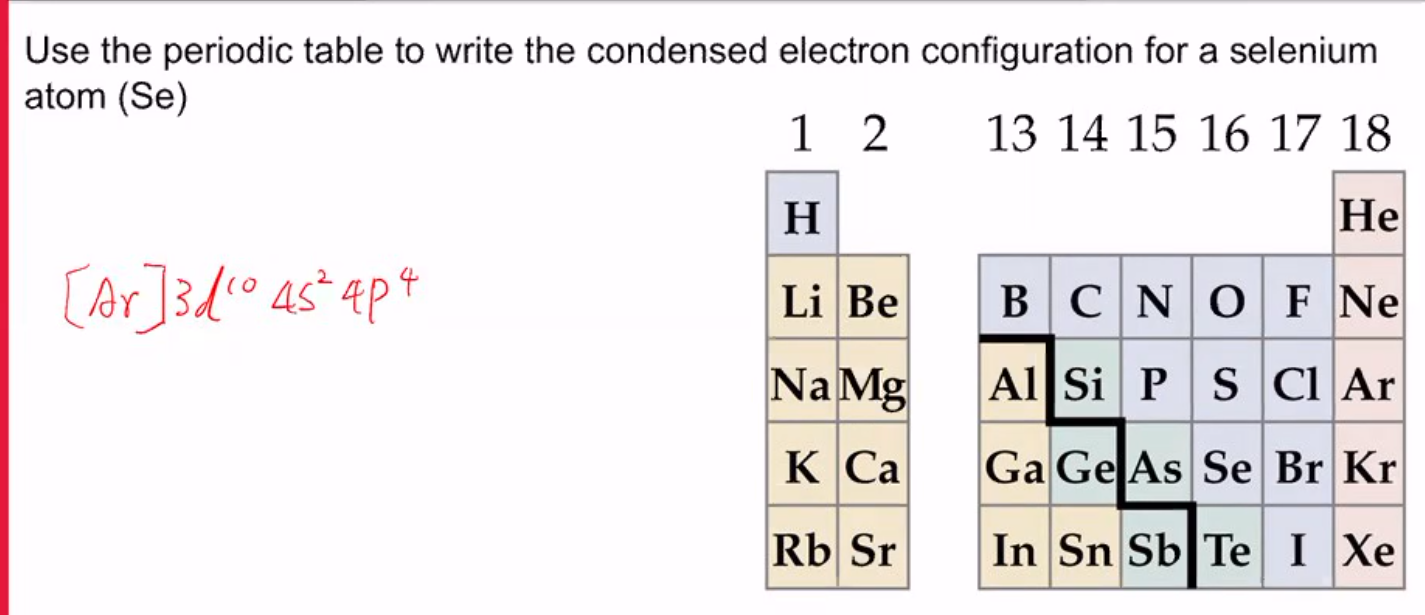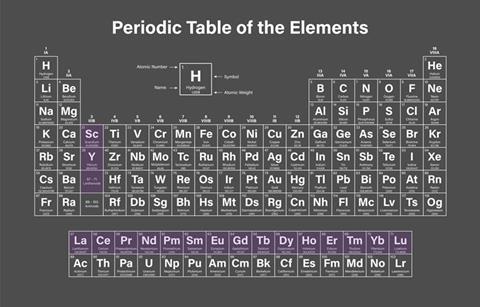Se Selenium Element information, facts. Selenium properties, uses and trends Periodic Table of the Elements - complete information about the selenium element - Facts, atomic mass, melting point, How to Locate on Periodic Table, History, Abundance, Physical Properties, Thermal Properties, Crystal Structure, Atomic & Orbital Properties, electron configuration, Chemical Properties selenium. Selenium (Se) From Wikipedia, the free encyclopedia Selenium is a chemical element with symbol Se and atomic number 34. It is a nonmetal with properties that are intermediate between those of its periodic table column-adjacent chalcogen elements sulfur and tellurium. Silicon is a chemical element with atomic number 14 which means there are 14 protons and 14 electrons in the atomic structure. Se 34 Bromine 79.90 Br 35 83.80 Kr 36 Strontium 87.62 Sr. The periodic table of the elements is a non-embedded designated support for the grade eight and high.
Element Selenium - Se
Comprehensive data on the chemical element Selenium is provided on this page; including scores of properties, element names in many languages, most known nuclides of Selenium. Common chemical compounds are also provided for many elements. In addition technical terms are linked to their definitions and the menu contains links to related articles that are a great aid in one's studies.
Selenium Menu
- Selenium Page One
- Selenium Page Two
- Selenium Page Three
Overview of Selenium
- Atomic Number: 34
- Group: 16
- Period: 4
- Series: Nonmetals
Selenium's Name in Other Languages
- Latin: Selenium
- Czech: Selen
- Croatian: Selenij
- French: Sélénium
- German: Selen - r
- Italian: Selenio
- Norwegian: Selen
- Portuguese: Selênio
- Russian: Селен
- Spanish: Selenio
- Swedish: Selen
Atomic Structure of Selenium
- Atomic Radius: 1.22Å
- Atomic Volume: 16.45cm3/mol
- Covalent Radius: 1.16Å
- Cross Section (Thermal Neutron Capture) σa/barns: 11.7
- Crystal Structure: Hexagonal
- Electron Configuration:
- 1s2 2s2p6 3s2p6d10 4s2p4
- Electrons per Energy Level: 2,8,18,6
- Shell Model
- Shell Model
- Ionic Radius: 0.5Å
- Filling Orbital: 4p4
- Number of Electrons (with no charge): 34
- Number of Neutrons (most common/stable nuclide): 45
- Number of Protons: 34
- Oxidation States: ±2,4,6
- Valence Electrons: 4s2p4
- Electron Dot Model
- Electron Dot Model

Chemical Properties of Selenium

- Electrochemical Equivalent: 0.7365g/amp-hr
- Electron Work Function: 5.9eV
- Electronegativity: 2.55 (Pauling); 2.48 (Allrod Rochow)
- Heat of Fusion: 6.694kJ/mol
- Incompatibilities:
- Acids, strong oxidizers, chromium trioxide, potassium bromate, cadmium
- Ionization Potential
- First: 9.752
- Second: 21.19
- Third: 30.82
- Valence Electron Potential (-eV): 120
Physical Properties of Selenium
- Atomic Mass Average: 78.96
- Boiling Point: 958K 685°C 1265°F
- Coefficient of lineal thermal expansion/K-1: 36.9E-6
- Conductivity
- Electrical: 1.0E-12 106/cm Ω
Thermal: 0.0204 W/cmk
- Electrical: 1.0E-12 106/cm Ω
- Density: 4.79g/cc @ 300K
- Description:
- Dark gray lustrous rods or dark red crystals of non-metal. Burns in contact with air but is unaffected by water. Disolves in alkalis and concentrated HNO3.
- Elastic Modulus:
- Bulk: 8.3/GPa
- Rigidity: 3.7/GPa
- Youngs: 58/GPa
- Enthalpy of Atomization: 205.9 kJ/mole @ 25°C
- Enthalpy of Fusion: 6.69 kJ/mole
- Enthalpy of Vaporization: 26.3 kJ/mole
- Flammablity Class: Combustible Solid
- Freezing Point:see melting point
- Hardness Scale
- Brinell: 736 MN m-2
- Mohs: 2
- Heat of Vaporization: 37.7kJ/mol
- Melting Point: 494K 221°C 430°F
- Molar Volume: 16.42 cm3/mole
- Optical Refractive Index: 1.000895
- Physical State (at 20°C & 1atm): Solid
- Specific Heat: 0.32J/gK
- Vapor Pressure = 0.695Pa@221°C
Regulatory / Health
- CAS Number
- 7782-49-2 powder
- UN/NA ID and ERG Guide Number
- 2658 / 152 powder
- RTECS: VS7700000
- OSHAPermissible Exposure Limit (PEL)
- TWA: 0.2 mg/m3
- OSHA PEL Vacated 1989
- TWA: 0.2 mg/m3
- NIOSHRecommended Exposure Limit (REL)
- TWA: 0.2 mg/m3
- IDLH: 1 mg/m3
- Routes of Exposure: Inhalation; Ingestion; Skin and/or eye contact
- Target Organs: Eyes, skin, respiratory system, liver, kidneys, blood, spleen
- Levels In Humans:
Note: this data represents naturally occuring levels of elements in the typical human, it DOES NOT represent recommended daily allowances.- Blood/mg dm-3: 0.171
- Bone/p.p.m: 1-9
- Liver/p.p.m: 0.35-2.4
- Muscle/p.p.m: 0.42-1.9
- Daily Dietary Intake: 0.006-0.2 mg
- Total Mass In Avg. 70kg human: 10-65 mg
Who / Where / When / How
- Discoverer: Jöns J. Berzelius
- Discovery Location: Stockholm Sweden
- Discovery Year: 1817
- Name Origin:
- Greek: Selênê (Moon)
- Abundance of Selenium:
- Earth's Crust/p.p.m.: 0.05
- Seawater/p.p.m.:
- Atlantic Suface: 4.6E-08
- Atlantic Deep: 1.8E-07
- Pacific Surface: 1.5E-08
- Pacific Deep: 1.65E-07
- Atmosphere/p.p.m.: N/A
- Sun (Relative to H=1E12): N/A
- Sources of Selenium:
- Obtained as a by-product of lead, copper and nickel refining. World wide annual production is around 600 tons. Primary mining areas are Canada, USA, Bolivia and Russia.
- Uses of Selenium:
- Used in photoelectric cells, TV cameras, as a semiconductor in solar batteries, light meters, copy machines, anti-dandruff shampoo and rectifiers. Also colors glass red.
- Additional Notes:
- A dose of selenium as small as 5 mg per day can be lethal for many humans.
Selenium Menu
Facts About The Periodic Table
- Selenium Page One
- Selenium Page Two
- Selenium Page Three

References
A list of reference sources used to compile the data provided on our periodic table of elements can be found on the main periodic table page.
Related Resources
- Anatomy of the Atom
Answers many questions regarding the structure of atoms. - Molarity, Molality and Normality
Introduces stoichiometry and explains the differences between molarity, molality and normality. - Molar Mass Calculations and Javascript Calculator
Molar mass calculations are explained and there is a JavaScript calculator to aid calculations. - Chemical Database
This database focuses on the most common chemical compounds used in the home and industry.
Citing this page
Charges Periodic Table
If you need to cite this page, you can copy this text:
Kenneth Barbalace. Periodic Table of Elements - Selenium - Se. EnvironmentalChemistry.com. 1995 - 2021. Accessed on-line: 5/3/2021
https://EnvironmentalChemistry.com/yogi/periodic/Se.html
.
Linking to this page
If you would like to link to this page from your website, blog, etc., copy and paste this link code (in red) and modify it to suit your needs:
Se Periodic Table Protons

Chemical Properties of Selenium
- Electrochemical Equivalent: 0.7365g/amp-hr
- Electron Work Function: 5.9eV
- Electronegativity: 2.55 (Pauling); 2.48 (Allrod Rochow)
- Heat of Fusion: 6.694kJ/mol
- Incompatibilities:
- Acids, strong oxidizers, chromium trioxide, potassium bromate, cadmium
- Ionization Potential
- First: 9.752
- Second: 21.19
- Third: 30.82
- Valence Electron Potential (-eV): 120
Physical Properties of Selenium
- Atomic Mass Average: 78.96
- Boiling Point: 958K 685°C 1265°F
- Coefficient of lineal thermal expansion/K-1: 36.9E-6
- Conductivity
- Electrical: 1.0E-12 106/cm Ω
Thermal: 0.0204 W/cmk
- Electrical: 1.0E-12 106/cm Ω
- Density: 4.79g/cc @ 300K
- Description:
- Dark gray lustrous rods or dark red crystals of non-metal. Burns in contact with air but is unaffected by water. Disolves in alkalis and concentrated HNO3.
- Elastic Modulus:
- Bulk: 8.3/GPa
- Rigidity: 3.7/GPa
- Youngs: 58/GPa
- Enthalpy of Atomization: 205.9 kJ/mole @ 25°C
- Enthalpy of Fusion: 6.69 kJ/mole
- Enthalpy of Vaporization: 26.3 kJ/mole
- Flammablity Class: Combustible Solid
- Freezing Point:see melting point
- Hardness Scale
- Brinell: 736 MN m-2
- Mohs: 2
- Heat of Vaporization: 37.7kJ/mol
- Melting Point: 494K 221°C 430°F
- Molar Volume: 16.42 cm3/mole
- Optical Refractive Index: 1.000895
- Physical State (at 20°C & 1atm): Solid
- Specific Heat: 0.32J/gK
- Vapor Pressure = 0.695Pa@221°C
Regulatory / Health
- CAS Number
- 7782-49-2 powder
- UN/NA ID and ERG Guide Number
- 2658 / 152 powder
- RTECS: VS7700000
- OSHAPermissible Exposure Limit (PEL)
- TWA: 0.2 mg/m3
- OSHA PEL Vacated 1989
- TWA: 0.2 mg/m3
- NIOSHRecommended Exposure Limit (REL)
- TWA: 0.2 mg/m3
- IDLH: 1 mg/m3
- Routes of Exposure: Inhalation; Ingestion; Skin and/or eye contact
- Target Organs: Eyes, skin, respiratory system, liver, kidneys, blood, spleen
- Levels In Humans:
Note: this data represents naturally occuring levels of elements in the typical human, it DOES NOT represent recommended daily allowances.- Blood/mg dm-3: 0.171
- Bone/p.p.m: 1-9
- Liver/p.p.m: 0.35-2.4
- Muscle/p.p.m: 0.42-1.9
- Daily Dietary Intake: 0.006-0.2 mg
- Total Mass In Avg. 70kg human: 10-65 mg
Who / Where / When / How
- Discoverer: Jöns J. Berzelius
- Discovery Location: Stockholm Sweden
- Discovery Year: 1817
- Name Origin:
- Greek: Selênê (Moon)
- Abundance of Selenium:
- Earth's Crust/p.p.m.: 0.05
- Seawater/p.p.m.:
- Atlantic Suface: 4.6E-08
- Atlantic Deep: 1.8E-07
- Pacific Surface: 1.5E-08
- Pacific Deep: 1.65E-07
- Atmosphere/p.p.m.: N/A
- Sun (Relative to H=1E12): N/A
- Sources of Selenium:
- Obtained as a by-product of lead, copper and nickel refining. World wide annual production is around 600 tons. Primary mining areas are Canada, USA, Bolivia and Russia.
- Uses of Selenium:
- Used in photoelectric cells, TV cameras, as a semiconductor in solar batteries, light meters, copy machines, anti-dandruff shampoo and rectifiers. Also colors glass red.
- Additional Notes:
- A dose of selenium as small as 5 mg per day can be lethal for many humans.
Selenium Menu
Facts About The Periodic Table
- Selenium Page One
- Selenium Page Two
- Selenium Page Three
References
A list of reference sources used to compile the data provided on our periodic table of elements can be found on the main periodic table page.
Related Resources
- Anatomy of the Atom
Answers many questions regarding the structure of atoms. - Molarity, Molality and Normality
Introduces stoichiometry and explains the differences between molarity, molality and normality. - Molar Mass Calculations and Javascript Calculator
Molar mass calculations are explained and there is a JavaScript calculator to aid calculations. - Chemical Database
This database focuses on the most common chemical compounds used in the home and industry.
Citing this page
Charges Periodic Table
If you need to cite this page, you can copy this text:
Kenneth Barbalace. Periodic Table of Elements - Selenium - Se. EnvironmentalChemistry.com. 1995 - 2021. Accessed on-line: 5/3/2021
https://EnvironmentalChemistry.com/yogi/periodic/Se.html
.
Linking to this page
If you would like to link to this page from your website, blog, etc., copy and paste this link code (in red) and modify it to suit your needs:
Se Periodic Table Protons
echo Periodic Table of Elements: Selenium - Se (EnvironmentalChemistry.com)- Comprehensive information for the element Selenium - Se is provided by this page including scores of properties, element names in many languages, most known nuclides and technical terms are linked to their definitions.
.
NOTICE: While linking to articles is encouraged, OUR ARTICLES MAY NOT BE COPIED TO OR REPUBLISHED ON ANOTHER WEBSITE UNDER ANY CIRCUMSTANCES.
PLEASE, if you like an article we published simply link to it on our website do not republish it.

